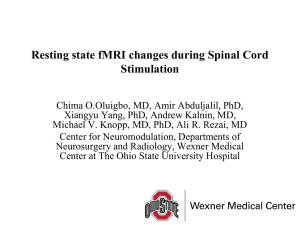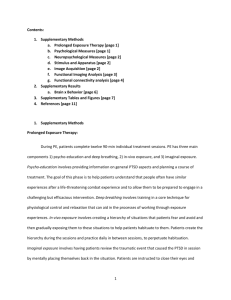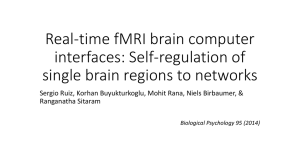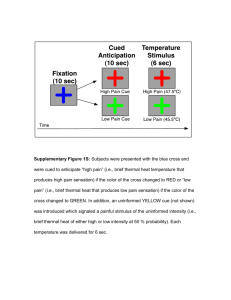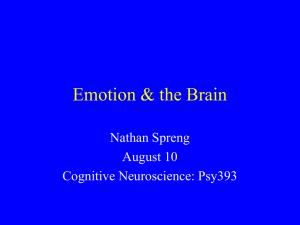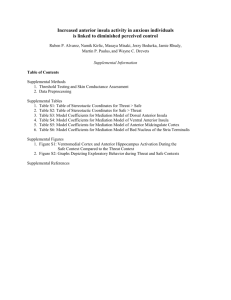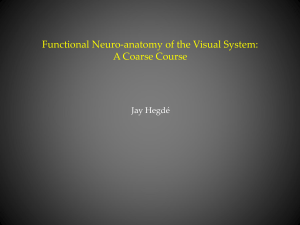- UCL Discovery
advertisement
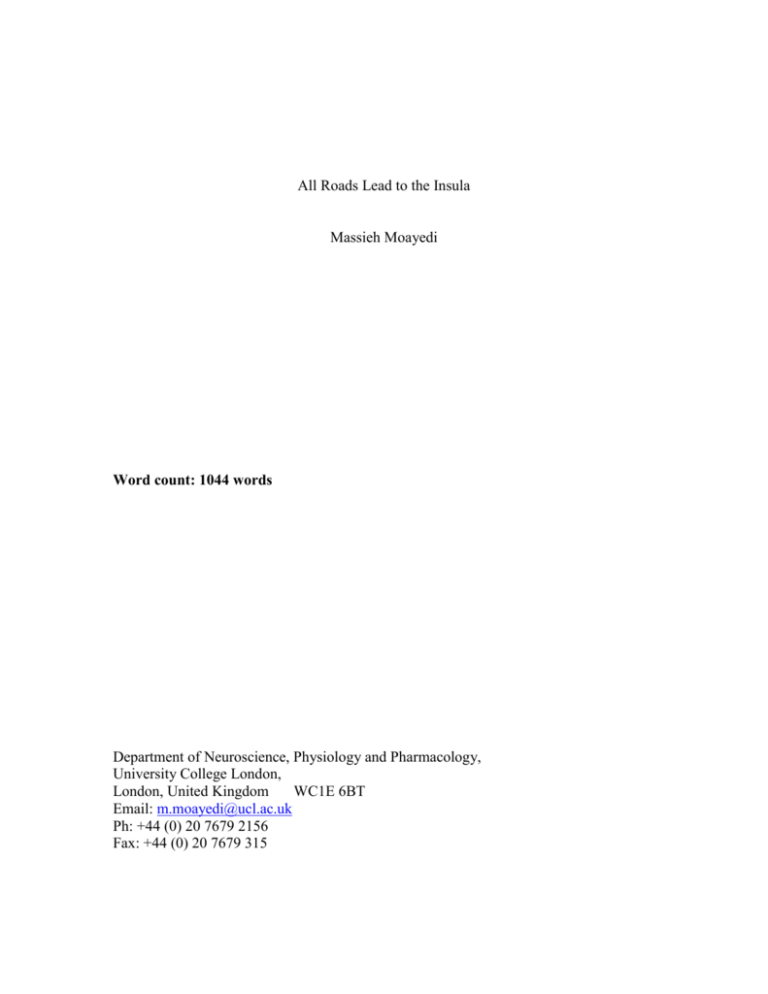
All Roads Lead to the Insula Massieh Moayedi Word count: 1044 words Department of Neuroscience, Physiology and Pharmacology, University College London, London, United Kingdom WC1E 6BT Email: m.moayedi@ucl.ac.uk Ph: +44 (0) 20 7679 2156 Fax: +44 (0) 20 7679 315 The multidimensional concept of pain, as proposed by Melzack and Casey [24], has stood the test of time, as well as that of rigour of the scientific method [25]. The concept of pain as a multidimensional experience has been described in ancient texts, dating as far back as the Syriac Empire (ca 200 BCE) [5]. The current definition comprises three dimensions: the sensory-discriminative (intensity, location, quality, and duration), the affective-motivational (unpleasantness and the subsequent flight response) and the cognitive-evaluative (appraisal, cultural and/or religious values, context and cognitive state). Although these three dimensions interact to form the pain experience, they are experimentally dissociable [27,28], which allows for the investigation of the unique neural underpinnings of individual dimensions. As of yet, no study has demonstrated that any single brain area is both necessary and sufficient to elicit the pain experience. As Marshall [22] suggested, S1 (and likely other cortical regions) receives and processes nociceptive input (likely sensory-discriminative information); however, this is not the region where the nociceptive input is perceived as pain. Rather, this information is processed and “sent” to other brain regions where the percept of pain occurs. To address this point, Melzack suggested that a network of brain regions working together is required for the percept of pain [23]. This pain “neuromatrix”, as he called it, can account for the multidimensional experience of pain. This theory proposed that to have a conscious experience of pain, many brain regions, each related to a dimension of pain, are required. For example, the sensory-discriminative dimension of pain has been associated with somatosensory areas, such as the primary and secondary somatosensory cortices (S1, S2) and the posterior insula [17]. The affectivemotivational dimension has been associated with the insula, the cingulate and other limbic regions; the cognitive-evaluative dimension has been associated with the prefrontal cortices, the cingulate and the insula [31]. However, no single dimension is sufficient to elicit a painful experience. This theory provides an explanation for the finding that stimulating a single brain region does not consistently produce pain. However, the concept of the so-called “pain matrix” idea has been discredited, and other theories about cortical brain regions have been postulated (for a review, see [9,14]). Thus, a fundamental question that remains in pain research is to elucidate how and where these various dimensions converge and are integrated to elicit pain, sometimes referred to as the binding problem. One brain region that is commonly associated with all of the dimensions of pain is the insula – and for this reason, amongst others, it has been proposed to be the site of pain integration. The insula is a very large, heterogeneous region implicated in a variety of functions. It is comprised of two long sulci in the posterior portion, and three short sulci in the anterior portion [1,2]. The insula can be divided into three subregions: the anterior, middle and posterior insula, based on functional and anatomical features [2]. Several studies have found that the insular subregions have differential structural and functional connectivity [6,10,19,26,30,32]. The paper by Wiech and colleagues investigates the structural and functional connectivity of the three insular subregions to pain-related brain regions. The study confirmed previous findings that the three subregions showed largely congruent patterns of connectivity, but with some notable differences between subregions and pain-related regions. Specifically, they found that the posterior insula had greater connectivity to somatosensory regions – and is thus likely related to the sensory dimension of pain; the anterior insula had greater connectivity to the ventrolateral prefrontal cortex, and is thus likely related to the cognitive-motivational aspects of the pain experience. Further support for this comes from their finding that structural connectivity between the anterior insula and the amygdala was positively correlated with pain vigilance and awareness, whereas anterior insula-rostral anterior cingulate cortex structural connectivity was negatively correlated with pain vigilance and awareness. Interestingly, rather than having a unique connectivity pattern, the mid-insula was connected to both somatosensory and prefrontal regions. The authors speculate that the differential connectivity may be related to the different roles of the insular subregions in pain perception; i.e., the various dimensions of pain. The study did not, however, investigate measures uniquely related to the other dimensions of pain. A number of theories about the role of the insula in pain perception have been postulated. For instance, Coghill and colleagues reported that the insula responds in a graded fashion to increasing intensity of noxious stimuli, suggests that it encodes pain intensity [7]. Brooks and Tracey [4] suggested that the insula is a multidimensional integration site for pain. An alternative hypothesis about the role of the insula proposed by Craig [8] suggested that the mid-posterior insula was a multimodal homeostatic or interoceptive area. The former hypothesis maintained pain as a separate modality, whereas Craig’s hypothesis established pain as a subset of homeostatic function. Garcia-Larrea has posited that the posterior insula is akin to tertiary somatosensory cortex (S3) which receives direct input from the spinothalamic system and produces pain through network interaction with other brain regions [16]. Baliki and colleagues [3] have posited another hypothesis suggesting that, in addition to integrating the dimensions of pain perception, the insula is a central, multimodal magnitude estimator and a nociceptive-specific magnitude estimator. The findings in the Wiech and colleagues study support the concept that nociceptive information is processed serially along the insula along the posterioranterior axis, each segment related to a different dimension of pain, and becoming fully integrated in the anterior insula. Recent findings by Frot and colleagues support this model [15]. However, there are some notable problems with many of these interpretations: (1) The anterior insula has been implicated in a multimodal sensory stimulus salience detection network, where salience stimuli are encoded and processed to appropriately orient attention [11-13,21]. It is also one of the most commonly activated brain region across all neuroimaging studies [33]. Given that pain is inherently salient, it is possible (or more likely) that the processes encoded in the insula reflect the salience of the stimulus. (2) There are other multimodal regions in the brain that are related to the various dimensions of pain (e.g., the cingulate cortex) [18,20,29]. Thus, future studies will need to investigate how insular connections contribute to the experience of pain, and its various dimensions, and parse these responses from generalized salience-related responses. CONFLICT OF INTEREST STATEMENT The author is aware of no conflicts of interest regarding this commentary. REFERENCES [1] Augustine JR. The insular lobe in primates including humans. Neurological Res 1985;7:2-10. [2] Augustine JR. Circuitry and functional aspects of the insular lobe in primates including humans. Brain Res Rev 1996;22:229-244. [3] Baliki MN, Geha PY, Apkarian AV. Parsing pain perception between nociceptive representation and magnitude estimation. J Neurophysiol 2009;101:875-887. [4] Brooks JC, Tracey I. The insula: a multidimensional integration site for pain. Pain 2007;128:1-2. [5] Budge EATW. The book of medicines : ancient Syrian anatomy, pathology and theraputics [sic]. London: Kegan Paul, 2002. [6] Cauda F, Costa T, Torta DM, Sacco K, D'Agata F, Duca S, Geminiani G, Fox PT, Vercelli A. Meta-analytic clustering of the insular cortex: characterizing the metaanalytic connectivity of the insula when involved in active tasks. Neuroimage 2012;62:343-355. [7] Coghill RC, Sang CN, Maisog JM, Iadarola MJ. Pain Intensity Processing Within the Human Brain: A Bilateral, Distributed Mechanism. J Neurophysiol 1999;82:19341943. [8] Craig AD. How do you feel? Interoception: the sense of the physiological condition of the body. Nat Rev Neurosci 2002;3:655-666. [9] Davis KD, Moayedi M. Central Mechanisms of Pain Revealed Through Functional and Structural MRI. Journal of neuroimmune pharmacology : the official journal of the Society on NeuroImmune Pharmacology 2013;8:518-534. [10] Dennis EL, Jahanshad N, McMahon KL, de Zubicaray GI, Martin NG, Hickie IB, Toga AW, Wright MJ, Thompson PM. Development of insula connectivity between ages 12 and 30 revealed by high angular resolution diffusion imaging. Hum Brain Mapp 2014;35:1790-1800. [11] Downar J, Crawley AP, Mikulis DJ, Davis KD. A cortical network for the detection of novel events across multiple sensory modalities. Neuroimage 2001;13:S310. [12] Downar J, Crawley AP, Mikulis DJ, Davis KD. A cortical network sensitive to stimulus salience in a neutral behavioral context across multiple sensory modalities. J Neurophysiol 2002;87:615-620. [13] Downar J, Mikulis DJ, Davis KD. Neural correlates of the prolonged salience of painful stimulation. Neuroimage 2003;20:1540-1551. [14] Farmer MA, Baliki MN, Apkarian AV. A dynamic network perspective of chronic pain. Neurosci Lett 2012;520:197-203. [15] Frot M, Faillenot I, Mauguiere F. Processing of nociceptive input from posterior to anterior insula in humans. Hum Brain Mapp 2014. [16] Garcia-Larrea L. The posterior insular-opercular region and the search of a primary cortex for pain. Neurophysiol Clin 2012;42:299-313. [17] Hofbauer RK, Rainville P, Duncan GH, Bushnell MC. Cortical representation of the sensory dimension of pain. J Neurophysiol 2001;86:402-411. [18] Hutchison WD, Davis KD, Lozano AM, Tasker RR, Dostrovsky JO. Pain-related neurons in the human cingulate cortex. Nat Neurosci 1999;2:403-405. [19] Kelly C, Toro R, Di Martino A, Cox CL, Bellec P, Castellanos FX, Milham MP. A convergent functional architecture of the insula emerges across imaging modalities. Neuroimage 2012;61:1129-1142. [20] Koyama T, Kato K, Tanaka YZ, Mikami A. Anterior cingulate activity during painavoidance and reward tasks in monkeys. Neurosci Res 2001;39:421-430. [21] Legrain V, Iannetti GD, Plaghki L, Mouraux A. The pain matrix reloaded: a salience detection system for the body. Prog Neurobiol 2011;93:111-124. [22] Marshall J. Sensory disturbances in cortical wounds with special reference to pain. J Neurol Neurosurg Psychiatry 1951;14:187-204. [23] Melzack R. Pain - an overview. Acta Anaesthesiol Scand 1999;43:880-884. [24] Melzack R, Casey KL. Sensory, motivational, and central control determinants of pain: a new conceptual model. In: D Kenshalo, editor. The Skin Senses. Springfield: C.C. Thomas, 1968. pp. 423-439. [25] Moayedi M, Davis KD. Theories of pain: from specificity to gate control. J Neurophysiol 2013;109:5-12. [26] Nanetti L, Cerliani L, Gazzola V, Renken R, Keysers C. Group analyses of connectivity-based cortical parcellation using repeated k-means clustering. Neuroimage 2009;47:1666-1677. [27] Rainville P, Carrier B, Hofbauer RK, Bushnell MC, Duncan GH. Dissociation of sensory and affective dimensions of pain using hypnotic modulation. Pain 1999;82:159-171. [28] Salomons TV, Moayedi M, Erpelding N, Davis KD. A brief cognitive-behavioural intervention for pain reduces secondary hyperalgesia. Pain 2014;155:1446-1452. [29] Shackman AJ, Salomons TV, Slagter HA, Fox AS, Winter JJ, Davidson RJ. The integration of negative affect, pain and cognitive control in the cingulate cortex. Nat Rev Neurosci 2011;12:154-167. [30] Taylor KS, Seminowicz DA, Davis KD. Two systems of resting state connectivity between the insula and cingulate cortex. Hum Brain Mapp 2009;30:2731-2745. [31] Treede RD, Kenshalo DR, Gracely RH, Jones AKP. The cortical representation of pain. Pain 1999;79:105-111. [32] Uddin LQ, Kinnison J, Pessoa L, Anderson ML. Beyond the tripartite cognitionemotion-interoception model of the human insular cortex. J Cogn Neurosci 2014;26:16-27. [33] Yarkoni T, Poldrack RA, Nichols TE, Van Essen DC, Wager TD. Large-scale automated synthesis of human functional neuroimaging data. Nature methods 2011;8:665-670.
